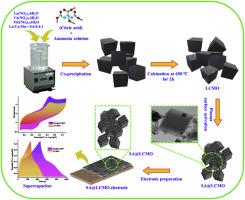利用氧等离子体开发表面活性 La0.6Ca0.4MnO3 包晶型电极,以实现高度稳定的超级电容器应用
IF 5.1
2区 材料科学
Q1 MATERIALS SCIENCE, CERAMICS
引用次数: 0
摘要
本研究介绍了一种新颖高效的方法来合成透辉石型纳米粒子,并采用先进的等离子体表面活化技术来显著提高超级电容器的性能。采用简便的共沉淀技术合成了具有晶体结构的高纯度 La0.6Ca0.4MnO3 (LCMO) 包晶石纳米粒子,然后在氧气环境中进行了创新的低压直流辉光放电等离子体处理。这种等离子体表面活化工艺增强了纳米粒子的表面特性,提高了它们的电化学性能,是储能材料的一种变革性改性方法。对合成和表面活化的 LCMO(SA@LCMO)纳米粒子进行的详细分析显示,它们具有清晰的立方体形态,经 TEM 和 BET 分析证实,其表面积高达 95 m2/g。经等离子体处理的 SA@LCMO 电极表现出卓越的超级电容器性能,在电流密度为 1 A/g 时,比电容高达 453 F/g,比未经处理的 LCMO 电极的 225.8 F/g 高出一倍多。此外,SA@LCMO 电极还表现出卓越的循环稳定性,在 10,000 次 GCD 循环后仍能保持 87% 的电容,库仑效率达到 95.2%。这种材料还显示出良好的储能能力,在功率密度为 170.6 W/kg 时,最大能量密度为 3.92 Wh/kg。这些结果凸显了等离子体表面活化对包晶体纳米材料的变革性影响,将 SA@LCMO 定位为下一代储能技术中极具潜力的候选材料,具有卓越的能量密度、耐用性和性能。这项研究为基于包晶材料的表面工程开辟了新的途径,以创建可扩展的高性能储能设备。本文章由计算机程序翻译,如有差异,请以英文原文为准。


Development of surface-activated La0.6Ca0.4MnO3 perovskite-type electrodes using oxygen plasma for highly stable supercapacitor application
This study introduces a novel and efficient approach for synthesizing perovskite-type nanoparticles and advanced plasma surface activation to significantly improve the supercapacitor's performance. High-purity La0.6Ca0.4MnO3 (LCMO) perovskite nanoparticles with a crystalline structure were synthesized using a facile coprecipitation technique, followed by an innovative low-pressure DC glow-discharge plasma treatment in an oxygen atmosphere. This plasma surface activation process enhances the surface properties of the nanoparticles and boosts their electrochemical performance, representing a transformative modification method for energy storage materials. Detailed analysis of the synthesized and surface-activated LCMO (SA@LCMO) nanoparticles revealed a well-defined cubic morphology with a remarkable surface area of 95 m2/g, as confirmed by TEM and BET analysis. The plasma-treated SA@LCMO electrodes demonstrated superior supercapacitor performance, delivering an impressive specific capacitance of 453 F/g at a current density of 1 A/g more than doubling the 225.8 F/g achieved by untreated LCMO electrodes. Additionally, the SA@LCMO electrodes exhibited exceptional cycle stability, retaining 87 % of their capacitance and achieving a coulombic efficiency of 95.2 % after 10,000 GCD cycles. The material also showed promising energy storage capabilities, with a maximum energy density of 3.92 Wh/kg at a power density of 170.6 W/kg. These results highlight the transformative impact of plasma surface activation on perovskite nanomaterials, positioning the SA@LCMO as a highly promising candidate for next-generation energy storage technologies with superior energy density, durability, and performance. This study introduces new avenues for surface engineering perovskite-based materials to create scalable high-performance energy storage devices.
求助全文
通过发布文献求助,成功后即可免费获取论文全文。
去求助
来源期刊

Ceramics International
工程技术-材料科学:硅酸盐
CiteScore
9.40
自引率
15.40%
发文量
4558
审稿时长
25 days
期刊介绍:
Ceramics International covers the science of advanced ceramic materials. The journal encourages contributions that demonstrate how an understanding of the basic chemical and physical phenomena may direct materials design and stimulate ideas for new or improved processing techniques, in order to obtain materials with desired structural features and properties.
Ceramics International covers oxide and non-oxide ceramics, functional glasses, glass ceramics, amorphous inorganic non-metallic materials (and their combinations with metal and organic materials), in the form of particulates, dense or porous bodies, thin/thick films and laminated, graded and composite structures. Process related topics such as ceramic-ceramic joints or joining ceramics with dissimilar materials, as well as surface finishing and conditioning are also covered. Besides traditional processing techniques, manufacturing routes of interest include innovative procedures benefiting from externally applied stresses, electromagnetic fields and energetic beams, as well as top-down and self-assembly nanotechnology approaches. In addition, the journal welcomes submissions on bio-inspired and bio-enabled materials designs, experimentally validated multi scale modelling and simulation for materials design, and the use of the most advanced chemical and physical characterization techniques of structure, properties and behaviour.
Technologically relevant low-dimensional systems are a particular focus of Ceramics International. These include 0, 1 and 2-D nanomaterials (also covering CNTs, graphene and related materials, and diamond-like carbons), their nanocomposites, as well as nano-hybrids and hierarchical multifunctional nanostructures that might integrate molecular, biological and electronic components.
 求助内容:
求助内容: 应助结果提醒方式:
应助结果提醒方式:


